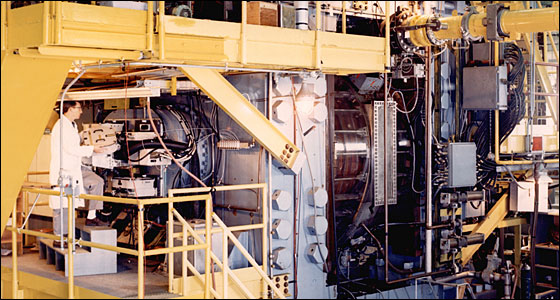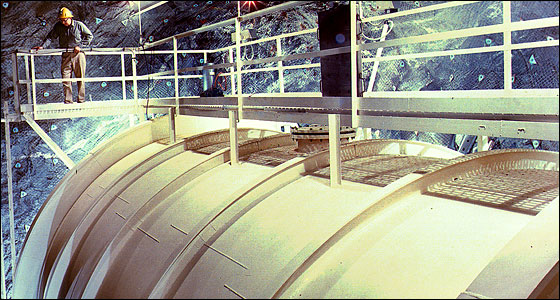BNL Timeline
APS Historic Site Home > BNL Timeline > 1958-1968
1958-1968

The 80-inch bubble chamber at the Alternating Gradient Synchrotron was once the largest particle detector of its type in the world
Brookhaven scientists see the advantages of strong focusing with the startup of the Alternating Gradient Synchrotron (AGS), which set records by accelerating protons to 33 billion electron volts. In its first years of operation, the AGS led to the discovery of the muon neutrino, securing the 1988 Nobel Prize in Physics; the omega-minus particle, found through tracks in the 80-inch bubble chamber at AGS; and charge parity (CP) violation, key to understanding why our universe is almost completely made up of matter and not equal amounts of matter and antimatter – a discovery that led to the 1980 Nobel Prize in Physics.
Two more reactors join the Brookhaven Graphite Research Reactor: the Brookhaven Medical Research Reactor and the High Flux Beam Reactor, which produced neutrons for studies in medicine, condensed matter physics, nuclear physics, and chemistry studies. The suite of reactors (dismantled in 1968, 2000, and 1999, respectively) also allowed the first application of neutron activation autoradiography, used to analyze oil paintings, sculptures, and archaeological artifacts.

About a mile under solid rock in South Dakota's Homestake Gold Mine, BNL researchers set up a chlorine-filled detector to measure neutrinos from the sun
BNL scientists determine that a ghostly type of particle called a neutrino has a spin that’s opposite to its momentum, giving it “negative helicity.” In a mine in South Dakota, BNL scientists are the first to confirm that the sun produces neutrinos, but only about one third of the number predicted by theory. The discovery of this “solar neutrino deficit” led to the 2002 Nobel Prize in Physics.
Brookhaven scientists also build a circular detector for early brain-imaging studies, a precursor to today's positron emission tomography machines; develop L-dopa as a treatment for Parkinson’s disease; and patent Maglev, the principle of superfast magnetically levitated transportation.